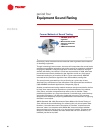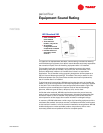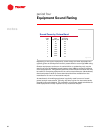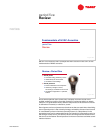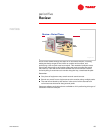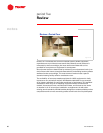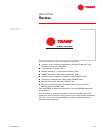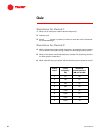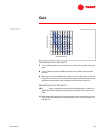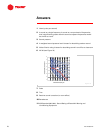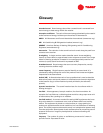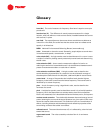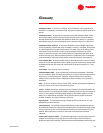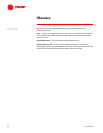
TRG-TRC007-EN 73
Glossary
reverberant field A uniform, or diffuse, sound field that is the opposite of a
free field. In a perfectly reverberant field, the sound-pressure level is equal at all
points.
reverberant room A specially constructed room with reflective walls, floors,
and ceilings. When a sound source is placed in this room, the sound waves
bounce back and forth between the reflective walls many times. In a perfectly
reverberant room, the sound-pressure level is equal at all points in the room.
reverberant-room method A common method for testing HVAC equipment.
It uses a specially-constructed room to create a uniform, or diffuse, sound field
by reflecting and mixing the sound waves. The walls, floor, and ceiling of the
reverberant room are hard in order to cause multiple reflections of sound
waves. In this environment, the sound pressure is essentially the same at all
locations in the room. Sound-pressure levels are measured in the reverberant
room and used to calculate sound-power levels for the piece of equipment.
room criteria (RC) A single number used to describe sound in a room. It uses a
series of curves and reference lines for plotting sound pressure by octave band
and determining the RC value and a descriptor of the sound quality (i.e., hiss,
rumble).
room effect See receiver room correction.
semireverberant field A sound field that is somewhere between a free field
and a reverberant field. The walls and ceiling of a room prevent the sound from
behaving in a free field manner, however, these surfaces are not perfectly
reflective. Some of the sound is reflected by these surfaces, but a portion is
absorbed.
sone A unit of measure, using a linear scale, used to describe the loudness of
a sound. A sone is the linear equivalent to a phon.
sound Audible emissions resulting from the vibration of molecules within an
elastic medium. It is generated by either a vibrating surface or the movement of
a fluid. In the context of building HVAC systems, this elastic medium can be
either air or the building structure. For structurally-borne sound to become
audible, however, it must first become airborne.
sound power The acoustical energy emitted by the sound source. It is not
affected by the environment.
sound pressure An audible pressure disturbance in the atmosphere that can
be measured directly. Its magnitude is influenced not only by the strength of the
source, but also by the surroundings and the distance from the source to the
listener. Sound pressure is what our ears hear and what sound meters
measure.
source–path–receiver model A systematic approach to analyzing the sound in
a space. It traces sound from the source to the location where we want to
predict the sound (the receiver). How the sound travels between the source and



